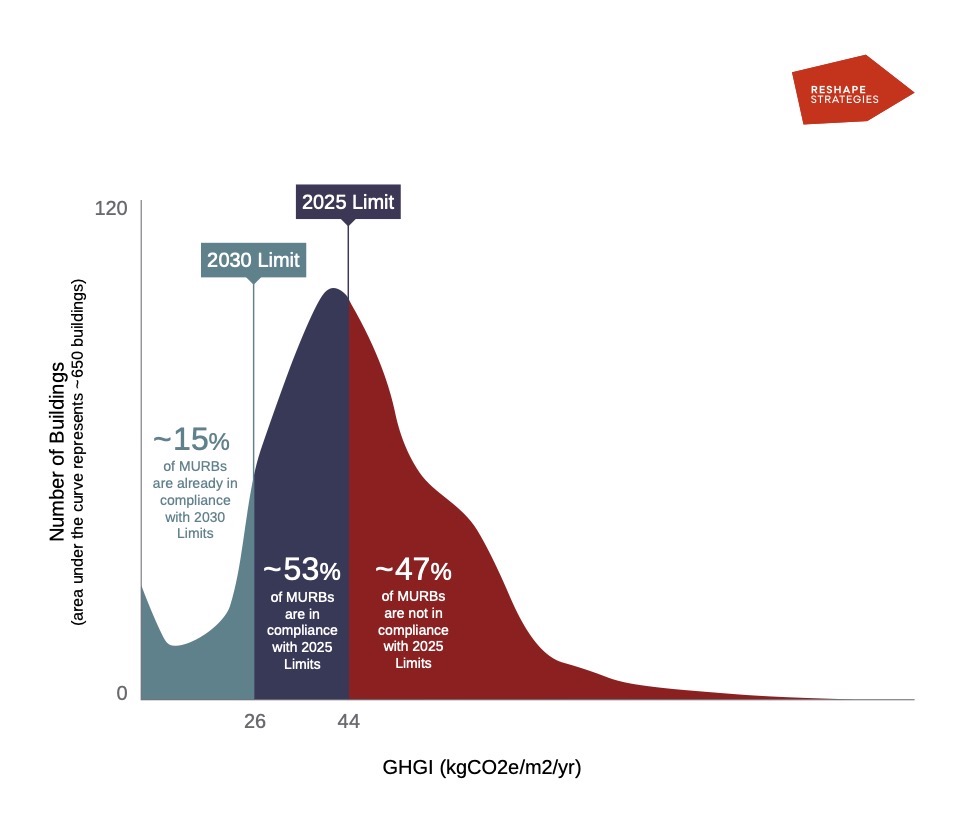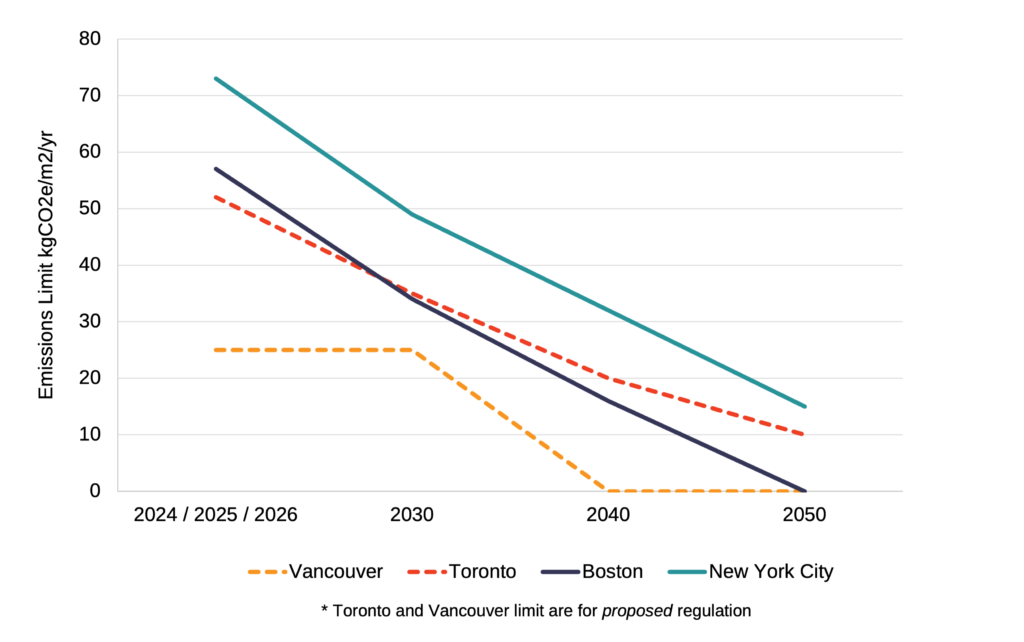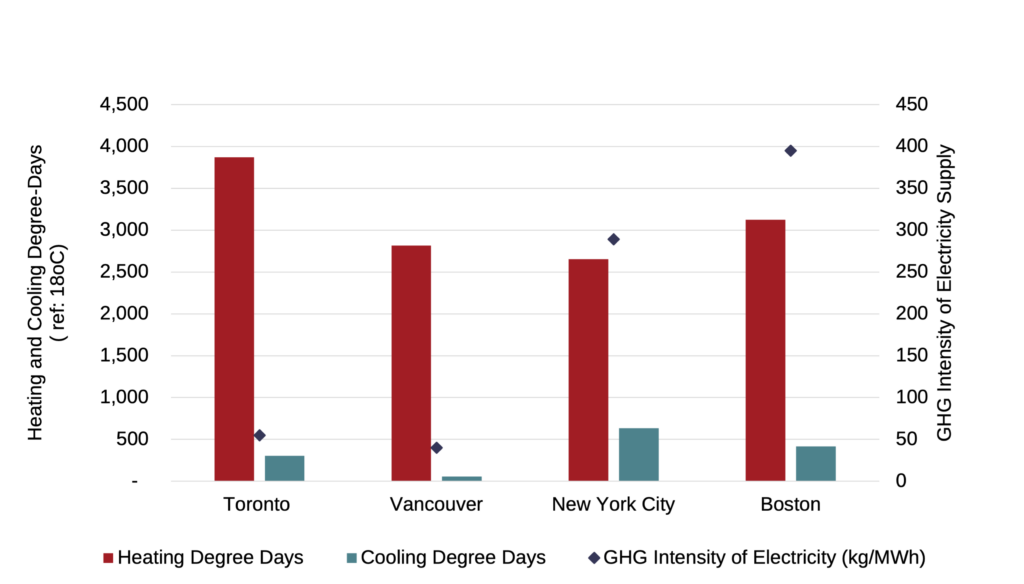
Preamble
To those of us who follow these things with keen interest, the City of Boston’s adoption of existing building emissions regulations in October 2021 hardly counts as “news” these days, and I’m definitely very late to the party with this post.
However, as this type of regulation is both urgently necessary and unfortunately rare, I wanted to make a point of examining how the amended “Building Energy Reporting and Disclosure Ordinance” or BERDO 2.0, will impact building emissions in Boston, and compare it to the existing legislation in New York City. The City’s expects that the outcome of BERDO will be a 50% reduction in the city’s total emissions by 2050 (further emissions reductions will come from other sectors included in the City’s climate action plan to achieve carbon neutrality).
History of BERDO
In 2014, Boston released its current iteration of the “Greenovate Climate Action Plan”, an update following seven years of work in reducing greenhouse gas (GHG) emissions throughout the city. While the plan includes action on emissions from all relevant sectors within the City, special emphasis was placed on the Buildings sector, and its heavy contribution to the City’s overall emissions. The Greenovate Plan reports that approximately 50% of Boston’s GHG emissions originate from the large buildings and institutions sector.
Originally enacted in 2013, BERDO was intended to track the energy and water use efficiency of Boston’s buildings to facilitate market recognition of efficiency and support targeted outreach on improvements. But as the focus of the energy conversation began to shift from energy efficiency towards decarbonization, the City’s 2019 Climate Action Plan introduced an amendment to BERDO, calling to replace the Energy Action and Assessment requirement with a Building Emissions Performance Standard by 2021.
How does BERDO drive decarbonization of Boston’s buildings?
Currently, BERDO requires that all commercial and residential buildings larger than 35,000 square feet, or having at least 35 units, report their energy and water use to the City of Boston. Building owners must self-certify their reporting data annually, and third-party verification of the data will be required starting in 2026 and every fifth year thereafter.
BERDO’s declining emissions limits for three common types of buildings, Office, Retail and Multi Unit Residential Buildings (MURBs), are shown in Table 1. However the legislation specifies limits for 13 different occupancy types including high-energy intensity occupancies such as healthcare and manufacturing. All buildings subject to reporting requirements must comply with the emission limit schedule. However, buildings can also opt to apply for an “Individual Compliance Schedule”, which serves as an alternate pathway to compliance.

Individual Compliance Schedules must aim for a 50% reduction in GHG emissions by 2030, moving to 100% by 2050. The baseline for this 50% reduction must be based on emissions from the first BERDO reporting year (2017) or any year back to 2005 if the data is available.
As an aside, it would appear that this Individual Compliance Schedule is a potential loophole in the legislation, since backdating the baseline year as far as possible would artificially inflate baseline emissions levels due to a steady decline in the electrical emission factors in Massachusetts from a peak in 2005, as coal and petroleum power generation has been phased out. This loophole could be closed by requiring that the baseline year emissions are calculated based on current electricity emissions factors.
How does BERDO affect Boston’s existing building stock?
Similar to our previous post on New York City’s trailblazing existing buildings emissions legislation, we compared the current existing building GHG emissions to the limits imposed by BERDO using publicly available Reported Energy and Water use data from the City of Boston’s website. Although the website now has energy and water use data from 2020, we based our analysis on 2019, before occupancy patterns we changed due to the COVID-19 pandemic. The results of the analysis for Multi-Unit Residential Buildings (MURBs) and Office Buildings are shown in Figures 1 and 2, respectively.


The analysis shows that unlike the New York City legislation, almost 50% of Boston’s existing MURBs will need to undertake some form of energy retrofit before 2025 in order to be in compliance with the BERDO emission limits. A similar analysis for the New York City legislation found that only about 25% of existing MURBs in NYC would be out of compliance when the law takes effect in 2024.
The results are similar for office buildings in Boston versus New York City; in New York City, about 20% of office buildings will be non-compliant with 2024 limits, while approximately 36% of office buildings in Boston will be non-compliant with the BERDO 2025 emissions limits.
We also observed that the impact of the pandemic and the move towards working from home is apparent in the difference between the 2019 and 2020 reporting data, particularly for Office buildings. Based on the 2020 data, only 16% of office buildings are out of compliance with the 2025 targets (compared with 36% in 2019). Perhaps counterintuitively, the MURB data set also showed a reduction in emissions intensity in 2020 relative to 2019 (37% non-compliant compared to 47%), however this reduction is less pronounced and may be partially accounted for by the fact that 2020 appears to have been a warmer year, on average, than 2019.
How does Boston compare to other Jurisdictions?
As shown in Figure 3, the BERDO emissions limits for office buildings are low compared to New York City, but fairly well aligned with proposed regulation in Toronto (at least in the early years). The City of Vancouver is also developing a framework for regulating existing building emissions, and the proposed limits for office buildings are significantly lower than those in NYC, Boston and Toronto. However, Vancouver also has the advantages of a mild climate and cleaner electricity than the other jurisdictions, as illustrated in Figure 4.

The ambitiousness of BERDO is further emphasized when the external factors influencing building emissions are taken into consideration. Boston has both a colder climate and a more carbon-intensive electricity supply than New York City, as shown in Figure 4. However, as mentioned earlier, a rapidly decarbonizing electricity supply can help facilitate compliance with BERDO limits, without any change at the building level, so 2025 and 2030 limits may be met without any building retrofits in some cases. In cities such as Toronto and Vancouver, electricity is already low-carbon and the challenge to decarbonize buildings is primarily a problem of decarbonizing heating.

How will compliance with BERDO be enforced?
BERDO sets forth comprehensive compliance pathways, as well as stringent penalties aiming to hold Boston’s building owners accountable for their contribution to the City’s decarbonization strategy. Compliance is determined by comparing a building’s reported GHGI to the limit specified in the regulation. Building owners can develop and request approval for Individual Compliance Schedules or request a Hardship Compliance Plan. Such Hardship Plans not only apply to buildings displaying financial hardship, but can be made applicable to buildings with historical designations, affordable housing units, and those with long-term energy supply contracts. In these cases, both the standards and corresponding timelines are reevaluated and customized.
Various compliance mechanisms exist, such as municipal aggregation (for building portfolio owners), renewable energy certificates, clean power purchase agreements, and “alternative compliance payments”. Alternative compliance payments are based on the estimated average cost per metric ton of CO2e to decarbonize buildings, currently set at USD $234 per metric ton of CO2e (the value will be reviewed every five years). Alternative compliance payments and fines will be placed into an Equitable Emissions Investment Fund, which will go towards the support, implementation, and administration of local carbon abatement projects, prioritizing Environmental Justice populations.
Failure to comply with BERDO will result in a fine of $300-$1,000 per day. Every day that a building is out of compliance with BERDO, a separate violation will be issued. For a building that reports non-compliant emissions over the course of an entire year, the annual cost of the fine would be in the range of $109,000-$365,000.

BERDO Supports Decarbonization of Existing District Energy Systems
The 2019 BERDO dataset indicates that over 20% of Boston’s large buildings (by floor area) are served by a steam district energy system (DES) and that emissions from the steam system amount to approximately 4,500 ktCO2/year. The owner of the Boston-Cambridge DES, Vicinity Energy, is already taking steps to decarbonize their system and has committed to Net Zero emissions by 2050 across all its operations.
In 2021, Vicinity committed to purchasing 100% renewable electricity for its Boston-Cambridge DES electricity use and to using biofuels produced from waste cooking oil to displace fossil fuel for generating steam. However, at the scale described by Vicinity, these changes will reduce total emissions from the Boston-Cambridge DES by less than 1%, and the addition of more low-carbon energy sources will be required for Vicinity to retain its steam customers once the BERDO emissions limits come into force in 2025. The ratcheting down of existing building emissions limits over time will mean that Vicinity will need to provide progressively more low-carbon heat to its customers to enable them to meet their emissions requirements.
The BERDO requirements represent both a challenge and an opportunity to Vicinity; decarbonizing the existing steam system will require Vicinity to develop and implement an Energy Transition Plan that will result in significant investment in new district infrastructure (representing tens to hundreds of millions of dollars). However, from the customer’s perspective, paying an increased rate for low-carbon district energy is a low-cost and low-impact pathway for BERDO compliance, relative to many of the alternatives (envelope and mechanical system retrofits, purchasing RECs or making compliance payments).
As of 2025, many buildings will no longer have the option to continue with “business-as-usual” without paying the hefty non-compliance fines imposed by BERDO. With the introduction of emissions limits in BERDO, the City of Boston has provided Vicinity with a basis for charging higher rates for low carbon heat or “Green Heat” and the legislation supports the business case for investment in the energy transition [1]. While there will certainly be increased costs associated with BERDO compliance, leveraging existing DE infrastructure to achieve deep emissions reductions is one of the most cost-effective pathways for achieving 2050 Net Zero targets.
As the Climate Emergency becomes more real with every passing year, more cities must follow in the footsteps of Boston and NYC to regulate existing building emissions to accelerate the transition to low-carbon heating and cooling.
[1] Reshape Strategies published a piece in the International District Energy Association magazine on Green Heat in 2018, read the article here.